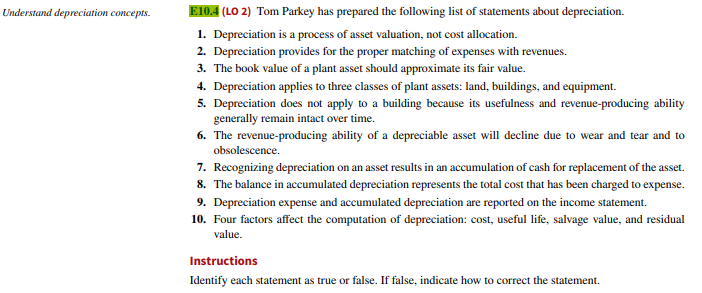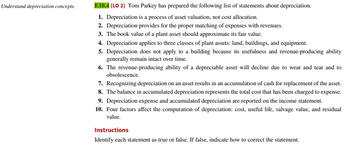Understand depreciation concepts. 2) Tom Parkey has prepared the following list of statements about depreciation. 1. Depreciation is a process of asset valuation, not cost allocation. 2. Depreciation provides for the proper matching of expenses with revenues. 3. The book value of a plant asset should approximate its fair value. 4. Depreciation applies to three classes of plant assets: land, buildings, and equipment. 5. Depreciation does not apply to a building because its usefulness and revenue-producing ability generally remain intact over time. 6. The revenue-producing ability of a depreciable asset will decline due to wear and tear and to obsolescence. 7. Recognizing depreciation on an asset results in an accumulation of cash for replacement of the asset. 8. The balance in accumulated depreciation represents the total cost that has been charged to expense. 9. Depreciation expense and accumulated depreciation are reported on the income statement. 10. Four factors affect the computation of depreciation: cost, useful life, salvage value, and residual
Understand depreciation concepts. 2) Tom Parkey has prepared the following list of statements about depreciation. 1. Depreciation is a process of asset valuation, not cost allocation. 2. Depreciation provides for the proper matching of expenses with revenues. 3. The book value of a plant asset should approximate its fair value. 4. Depreciation applies to three classes of plant assets: land, buildings, and equipment. 5. Depreciation does not apply to a building because its usefulness and revenue-producing ability generally remain intact over time. 6. The revenue-producing ability of a depreciable asset will decline due to wear and tear and to obsolescence. 7. Recognizing depreciation on an asset results in an accumulation of cash for replacement of the asset. 8. The balance in accumulated depreciation represents the total cost that has been charged to expense. 9. Depreciation expense and accumulated depreciation are reported on the income statement. 10. Four factors affect the computation of depreciation: cost, useful life, salvage value, and residual
College Accounting, Chapters 1-27
23rd Edition
ISBN:9781337794756
Author:HEINTZ, James A.
Publisher:HEINTZ, James A.
Chapter5: Adjusting Entries And The Work Sheet
Section: Chapter Questions
Problem 1MC: LO1 The purpose of depreciation is to (a) spread the cost of an asset over its useful life. (b) show...
Related questions
Question
E10.4

Transcribed Image Text:Understand depreciation concepts.
E10.4 (LO 2) Tom Parkey has prepared the following list of statements about depreciation.
1. Depreciation is a process of asset valuation, not cost allocation.
2. Depreciation provides for the proper matching of expenses with revenues.
3. The book value of a plant asset should approximate its fair value.
4. Depreciation applies to three classes of plant assets: land, buildings, and equipment.
5. Depreciation does not apply to a building because its usefulness and revenue-producing ability
generally remain intact over time.
6. The revenue-producing ability of a depreciable asset will decline due to wear and tear and to
obsolescence.
7. Recognizing depreciation on an asset results in an accumulation of cash for replacement of the asset.
8. The balance in accumulated depreciation represents the total cost that has been charged to expense.
9. Depreciation expense and accumulated depreciation are reported on the income statement.
10. Four factors affect the computation of depreciation: cost, useful life, salvage value, and residual
value.
Instructions
Identify each statement as true or false. If false, indicate how to correct the statement.
Expert Solution
This question has been solved!
Explore an expertly crafted, step-by-step solution for a thorough understanding of key concepts.
This is a popular solution!
Trending now
This is a popular solution!
Step by step
Solved in 2 steps

Follow-up Questions
Read through expert solutions to related follow-up questions below.
Follow-up Question
4, 5,6 please

Transcribed Image Text:Understand depreciation concepts.
E10.4 (LO 2) Tom Parkey has prepared the following list of statements about depreciation.
1. Depreciation is a process of asset valuation, not cost allocation.
2. Depreciation provides for the proper matching of expenses with revenues.
3. The book value of a plant asset should approximate its fair value.
4. Depreciation applies to three classes of plant assets: land, buildings, and equipment.
5. Depreciation does not apply to a building because its usefulness and revenue-producing ability
generally remain intact over time.
6. The revenue-producing ability of a depreciable asset will decline due to wear and tear and to
obsolescence.
7. Recognizing depreciation on an asset results in an accumulation of cash for replacement of the asset.
8. The balance in accumulated depreciation represents the total cost that has been charged to expense.
9. Depreciation expense and accumulated depreciation are reported on the income statement.
10. Four factors affect the computation of depreciation: cost, useful life, salvage value, and residual
value.
Instructions
Identify each statement as true or false. If false, indicate how to correct the statement.
Solution
Knowledge Booster
Learn more about
Need a deep-dive on the concept behind this application? Look no further. Learn more about this topic, accounting and related others by exploring similar questions and additional content below.Recommended textbooks for you

College Accounting, Chapters 1-27
Accounting
ISBN:
9781337794756
Author:
HEINTZ, James A.
Publisher:
Cengage Learning,

College Accounting, Chapters 1-27
Accounting
ISBN:
9781337794756
Author:
HEINTZ, James A.
Publisher:
Cengage Learning,